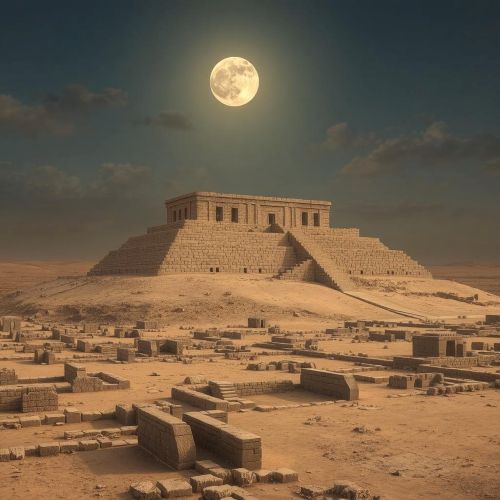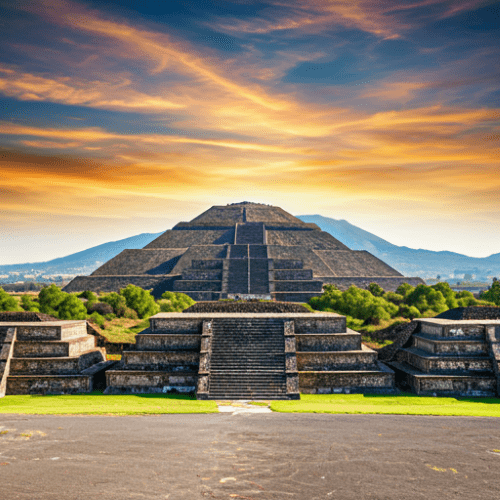
Ur : The City of the Moon
At a glance
| Description | |
|---|---|
| Mythology | Sumerian Mythology |
| Country | Iraq |
| Closest airport | Nasiriyah International Airport (XNH) |
| Type | Constructed |
| Accessibility | 10/10 |
Introduction
Tucked away in the southern plains of Iraq, Ur is one of the oldest and most influential cities of ancient Mesopotamia. Once a flourishing Sumerian metropolis, it played a central role in the cultural and religious life of the region for centuries. With its grand ziggurat, royal burial grounds, and intricate city layout, Ur offers a tangible connection to humanity’s earliest experiments with urban living, spiritual devotion, and governance. Founded around 3800 BCE, the city was both a beacon of innovation and a cornerstone of mythology, earning its place among the most studied archaeological sites in the world.
Connection with Mythology
Ur’s spiritual significance was tied closely to the worship of Nanna, the Sumerian moon god. The towering Ziggurat of Ur, constructed by King Ur-Nammu around 2100 BCE, stood as a place of reverence and ritual. Here, priests would ascend the sacred steps to commune with celestial forces, aligning the city’s destiny with divine will.
Beyond temple worship, Ur featured prominently in broader Sumerian cosmology. The mythology of this civilization imagined the world as emerging from primeval chaos, where gods like An (sky) and Ki (earth) birthed powerful deities such as Enlil and Enki—figures deeply respected in Ur’s pantheon. These deities shaped natural forces and human affairs, and their stories were recorded in cuneiform on clay tablets excavated from Ur.
The city is also linked, by tradition, to Abraham, a central figure in biblical texts. Known as “Ur of the Chaldees,” it adds a cross-cultural layer of reverence that continues to draw scholars and pilgrims alike, blending Sumerian myth with Abrahamic legacy.
Ways to Get There
Modern journeys to Ur begin in Nasiriyah, the nearest major city in Iraq’s Dhi Qar Governorate. Most international travelers fly into Baghdad International Airport, from where they can take a domestic flight or drive to Nasiriyah. The archaeological site lies just a short drive from there.
Though travel infrastructure has improved, visitors must stay informed about regional safety and obtain necessary permits. Several reputable tour operators now offer guided visits, ensuring both safe access and educational value, with expert insights into Ur’s historical and cultural importance.
What to Look For
Stepping onto the ruins of Ur is like walking into a living museum. The most iconic structure is undoubtedly the Ziggurat of Ur. Its immense size and sloped staircases provide a majestic view of the surrounding desert and an appreciation of ancient architectural mastery. Originally rising over 20 meters, the ziggurat was the focal point of religious and civic activity.
Equally compelling is the Royal Cemetery, unearthed by archaeologist Sir Leonard Woolley in the 1920s. These tombs date back to around 2600 BCE and were filled with precious artifacts, including gold helmets, lyres adorned with bull heads, and elaborately crafted jewelry. These findings speak volumes about the city’s wealth, artistry, and complex social hierarchy.
The remains of residential buildings, administrative centers, and additional temples offer insights into daily life, trade, and governance. One can still trace the layout of streets and imagine the hum of life that once filled this ancient city. Complementing the on-site experience are numerous artifacts housed in global institutions such as the British Museum and the Penn Museum, where pieces from Ur continue to be studied and displayed.
At the base of the hill lies Chalice Well, a sacred spring known for its reddish iron-rich waters. The well has long been associated with spiritual healing and Arthurian myths, and its tranquil gardens provide a serene contrast to the windswept summit. For those drawn to history, nearby Glastonbury Abbey—believed by some to be the final resting place of King Arthur—adds another layer of intrigue to this mystical landscape.
Importance in cultural history
Ur’s influence extended far beyond its physical boundaries. As a center of literacy and learning, it was home to early examples of cuneiform writing, which revolutionized human communication and record-keeping. The Code of Ur-Nammu, one of the oldest known legal texts, illustrates how this society was already engaging with ideas of law, justice, and order over four thousand years ago.
Its trade networks connected Ur to regions as far as the Indus Valley and Anatolia, reflecting a sophisticated economy rooted in agriculture, craftsmanship, and long-distance commerce. Politically, Ur was the capital during what is known as the Third Dynasty of Ur, a time marked by centralized governance, infrastructure projects, and bureaucratic efficiency.
Culturally, the blend of myth and statecraft in Ur offers a window into how ancient civilizations viewed power and divine favor. Kingship was not just political but also deeply spiritual, believed to be granted by the gods and enacted through ritual and architecture. This interweaving of myth and state laid the groundwork for future empires in the region.
Best time to travel
The most favorable months for exploring Ur fall between October and March, when temperatures are milder and more suited to walking among open ruins. Southern Iraq’s summer heat can be oppressive, often surpassing 45°C (113°F), which makes outdoor activities difficult and uncomfortable.
Winter and early spring also present clearer skies and fewer crowds, allowing for a more immersive and reflective experience. It’s advisable to check the latest travel advisories, secure permits in advance, and plan your trip with experienced guides to make the most of your journey.
Source
Ur | Mesopotamia, Map, Definition, History, & Facts | Britannica. (2025, April 22). Retrieved from https://www.britannica.com/place/Ur
Sumerian religion – Wikipedia. (n.d.). Retrieved from https://en.wikipedia.org/wiki/Sumerian_religion
Ancient Babylonian and Mesopotamian Archeological Sites You Can Visit in Iraq. (2025, April 19). Retrieved from https://www.inertianetwork.com/magazine/ancient-babylonian-and-mesopotamian-archeological-sites-you-can-visit-in-iraq
Ur – an ancient city in Iraq – we travel. (2024, May 21). Retrieved from https://we-travel.at/ur-an-ancient-city-in-iraq/
Ziggurat of Ur Day Tour from Nasiriyah – Iraq Travel and Tours. (n.d.). Retrieved from https://iraqtravelandtours.com/day-tours/day-tour-from-nasiriyah-ziggurat-of-ur/
Overview of the Ur archaeological site components – Urima. (n.d.). Retrieved from https://www.urima.org/history/ur/archaeological-sites/
Royal Cemetery at Ur – Wikipedia. (n.d.). Retrieved from https://en.wikipedia.org/wiki/Royal_Cemetery_at_Ur
Ur – Wikipedia. (n.d.). Retrieved from https://en.wikipedia.org/wiki/Ur
Discover the Ancient Marvel: The Great Ziggurat of Ur – Evendo. (n.d.). Retrieved from https://evendo.com/locations/iraq/mesopotamia/attraction/great-ziggurat-of-ur
Frequently Asked Questions
Lorem ipsum dolor sit amet, consectetur adipiscing?
Lorem ipsum dolor sit amet, consectetur adipiscing elit. Praesent convallis vestibulum justo, ac tincidunt nunc vehicula quis. Nullam id dolor quis orci malesuada feugiat. Curabitur aliquet libero at urna ullamcorper, ac ultricies nulla dapibus.
Lorem ipsum dolor sit amet, consectetur adipiscing?
Lorem ipsum dolor sit amet, consectetur adipiscing elit. Praesent convallis vestibulum justo, ac tincidunt nunc vehicula quis. Nullam id dolor quis orci malesuada feugiat. Curabitur aliquet libero at urna ullamcorper, ac ultricies nulla dapibus.
Lorem ipsum dolor sit amet, consectetur adipiscing?
Lorem ipsum dolor sit amet, consectetur adipiscing elit. Praesent convallis vestibulum justo, ac tincidunt nunc vehicula quis. Nullam id dolor quis orci malesuada feugiat. Curabitur aliquet libero at urna ullamcorper, ac ultricies nulla dapibus.
Lorem ipsum dolor sit amet, consectetur adipiscing?
Lorem ipsum dolor sit amet, consectetur adipiscing elit. Praesent convallis vestibulum justo, ac tincidunt nunc vehicula quis. Nullam id dolor quis orci malesuada feugiat. Curabitur aliquet libero at urna ullamcorper, ac ultricies nulla dapibus.
Lorem ipsum dolor sit amet, consectetur adipiscing?
Lorem ipsum dolor sit amet, consectetur adipiscing elit. Praesent convallis vestibulum justo, ac tincidunt nunc vehicula quis. Nullam id dolor quis orci malesuada feugiat. Curabitur aliquet libero at urna ullamcorper, ac ultricies nulla dapibus.








